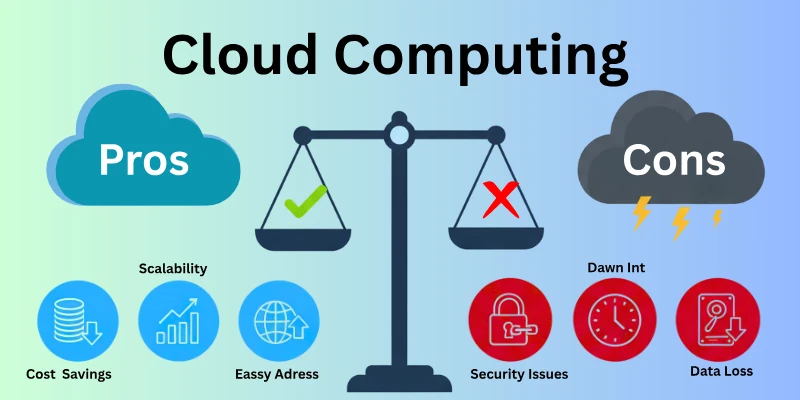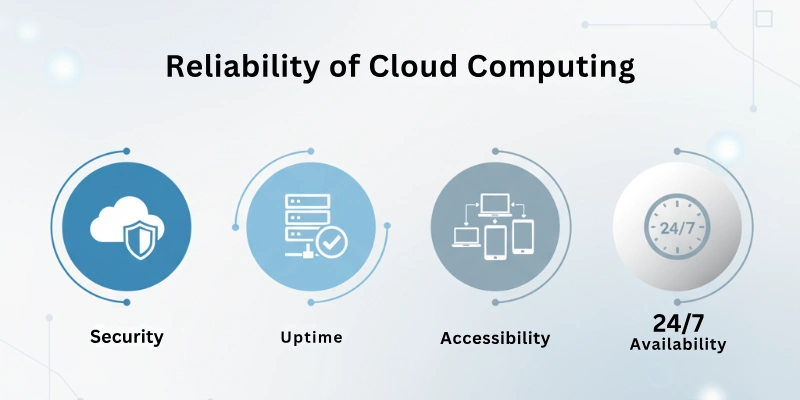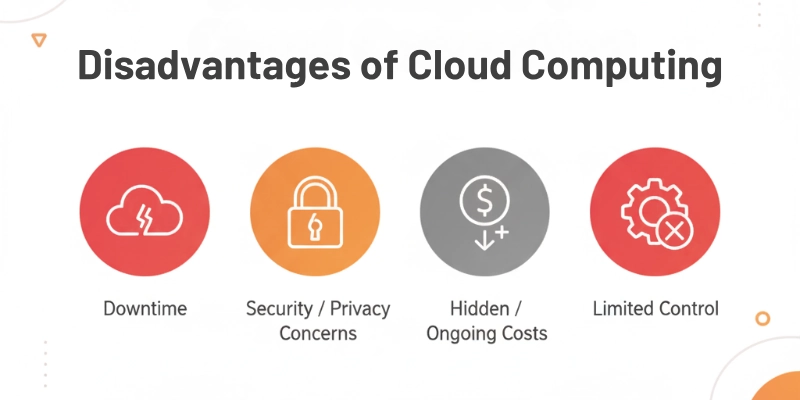Pros & Cons of Cloud Computing: Advantages vs. Disadvantages
Published: 1 Sep 2025
In this age of technology, where data is king, cloud computing has benefits that can’t be found anywhere else. But have you ever thought about the advantages and disadvantages of cloud computing?

These include the ability to grow, be accessed by anyone, and save money. However, like all modern wonders, it has some problems, such as security issues and the need to be connected to the internet.
We will break down the complicated aspects of cloud technology and talk about its pros and cons to give you a full picture of the current scenario.
Advantages of Cloud Computing
These days, cloud software is very popular, and for good reason! One of the biggest benefits is that it changes how we use and handle technology. The most important perks of cloud technology are as follows:
- Scalability
- Cost Savings
- Accessibility
- Flexibility
- Reliability
- Automatic Updates
- Collaboration Efficiency
- Disaster Recovery
- Resource Utilization Optimization
- Environmental Impact Reduction
- Speed and Agility
- Global Reach
- Security Improvements
- Data Redundancy
- Streamlined Performance Monitoring
Let’s dig in.
1. Scalability
Businesses can easily scale up or down their resources with cloud computing, so they can get the best results during busy times and save money when demand is low.
- Because of this, organizations can easily adjust to changing workloads without having to plan or spend a lot on new infrastructure.
- Scalability makes businesses more flexible, so they can quickly adapt to changes in the market and take advantage of new possibilities.
2. Cost Savings
Organisations can save money on capital investment by migrating from traditional on-premises infrastructure to the cloud.
- Cloud services use a pay-as-you-go model, allowing organisations to pay only for the resources they use, resulting in increased cost effectiveness.
- The cloud also reduces operational expenses such as maintenance, upgrades, and physical security.
3. Accessibility
Cloud computing offers global access to data and apps, allowing users to connect and work from anywhere with an internet connection.
- This accessibility promotes remote work capabilities, increasing flexibility and enabling teams to collaborate effortlessly.
- Users can access cloud services from a range of devices, which improves the overall user experience and productivity.
4. Flexibility
Cloud services include a variety of service models (Infrastructure as a Service (IaaS), Platform as a Service (PaaS), and Software as a Service (SaaS) to meet a wide range of business needs.
- Organizations can select deployment types (public, private, or hybrid) based on their requirements, resulting in a personalized approach to IT infrastructure.
- This flexibility promotes innovation by allowing organizations to experiment with new technologies and services.
5. Reliability
Cloud companies often deliver high levels of service availability and dependability.

- Advanced cloud backup and recovery options improve data reliability, integrity, and availability.
- Service Level Agreements (SLAs) guarantee a specific level of performance, providing businesses confidence in the dependability of their cloud-based apps and services.
6. Automatic Updates
Cloud service providers manage routine software updates, patches, and maintenance tasks, ensuring that applications and services always use the most recent versions.
- This reduces the need for IT personnel to manage and schedule updates.
- Automatic updates help to improve security by resolving vulnerabilities and possible threats.
7. Collaboration Efficiency
Cloud-based collaboration tools and platforms enable real-time communication and file sharing among team members.
- Multiple users can work on the same document at the same time, encouraging collaboration and reducing project timetable delays.
- Centralized access to common resources promotes communication, resulting in a more efficient and integrated workplace.
8. Disaster Recovery
Cloud services offer reliable data backup and recovery processes, ensuring that essential corporate data is safeguarded in the case of data loss.
- Cloud-based disaster recovery solutions are frequently more cost-effective than traditional approaches.
- The distributed nature of cloud infrastructure improves adaptability by reducing the chance of data loss.
9. Resource Utilization Optimization
Cloud computing enables businesses to maximize resource utilization by automatically allocating computing resources based on demand.
- Automated scaling ensures that resources are efficiently distributed.
- This optimization helps to improve performance, reduce costs, and increase overall operational effectiveness.
10. Environmental Impact Reduction
Multiple users can share the same physical infrastructure with cloud services, which lowers the general impact on the environment.
- Cloud service companies often put money into technologies and methods that use less energy and last longer.
- The cloud’s virtualized infrastructure also minimizes the need for on-premises hardware, leading to lower energy consumption and a smaller carbon footprint.
11. Speed and Agility
Cloud services make it easy for businesses to quickly add computing resources.
- This flexibility helps get goods and services to market faster, which gives companies an edge in the market.
- Overall responsiveness is improved by being able to quickly adjust to changing business needs.
12. Global Reach
Cloud computing lets companies grow their operations around the world without having to set up real infrastructure in each place.
- People all over the world can use the same tools and services, which creates a more unified and connected world.
- This global reach helps people from different countries work together and grow their markets.
13. Security Improvements
Cloud service companies put a lot of money into advanced security measures like encryption, access controls, and threat detection, which makes all data safer.
- A lot of the time, cloud services follow security standards and certifications that are common in the business.
- Cloud providers’ focus on security helps build a strong security stance that may be higher than what individual businesses can achieve on their own.
14. Data Redundancy
Many cloud storage systems use redundancy and data replication to spread data across many computers and data centers.
- Using redundant storage makes data last longer, so important files can still be accessed even if hardware or infrastructure breaks.
- This backup makes sure that the data is always safe and accessible.
15. Streamlined Performance Monitoring
Cloud platforms offer a wide range of performance monitoring tools and services that let companies watch and study how apps work.
- Real-time data and monitoring give you a lot of information about how the system is working.
- Streamlined performance tracking makes things more reliable, better for users, and more efficient.
Disadvantages of Cloud Computing
While cloud computing has numerous benefits, it is not without its drawbacks. Understanding the downsides is critical for making sound judgements about using cloud services.

So, here is the list of all the drawbacks of cloud technology:
- Security Concerns
- Dependency on Internet Connectivity
- Potential Downtime
- Limited Customization and Control
- Costs Over Time
- Data Privacy and Jurisdiction Concerns
- Learning Curve and Training
- Vendor Lock-In
Let’s get together and read about the limitations of cloud technology.
1. Security Concerns
People and businesses that use cloud computing give their private information to outside service companies.
- This makes them more worried about gaps, security leaks, and people getting in without permission.
- It is important to follow industry rules and data privacy guidelines to fix security problems and keep private information safe.
2. Dependency on Internet Connectivity
Many cloud services depend on being connected to the internet.
- And, when that connection is lost, important apps and data may not be available for a short time.
- Users who live in places where internet connections are slow or unreliable may have trouble getting cloud resources.
3. Potential Downtime
Cloud services are quite dependable, although they do occasionally fail, preventing customers from accessing services and leaving them offline.
- Organizations may encounter issues during scheduled maintenance windows or when services are disrupted without notice.
- To ensure ongoing operation, it is critical to take early steps to decrease downtime.
4. Limited Customization and Control
Cloud services typically provide traditional solutions, making it more difficult to make changes that meet the unique demands of a particular firm.
- The configuration options provided by the cloud provider may limit the capabilities of organizations.
- Business requirements must be carefully considered in order to strike a fair balance between the need for customization and the standard capabilities of cloud services.
5. Costs Over Time
Cloud services will cost you more in the long run, especially if your consumption changes or increases.
- Over time, expenses can rise due to wasteful resource utilization, unexpected data transfer fees, and additional payments for special services.
- To avoid budget issues, companies should establish clear cost structures.
6. Data Privacy and Jurisdiction Concerns
Data privacy concerns may occur when data is kept on the cloud.
- To ensure that you are obeying the requirements of data residency, you must be able to deal with the numerous complex legal and regulatory issues that arise.
- There is a potential that multiple countries’ data protection rules would clash, making data management and compliance more complicated.
7. Learning Curve and Training
Employees often need to learn skills and information to use cloud technologies.
- Moving to cloud-based workflows may necessitate training programs to ensure that cloud services are used correctly.
- Companies should invest in staff education and training to make them more productive and maximize their use of the cloud.
8. Vendor Lock-In
If you choose a cloud provider and use its services, you may get “vendor locked in,” making it difficult to switch to another source.
- Moving data and apps across cloud services can be time-consuming and costly.
- Careful consideration of solutions that do not rely on a single seller, as well as the use of open standards, can help reduce the risk of vendor lock-in.
Conclusion
So guys, in this article, we’ve explored the pros and cons of cloud technology. As we journey into the realm of cloud computing, we discover both its advantages and disadvantages. Guys, every coin has two sides, and the same holds true for Cloud Computing. But, with the right strategy and planning, challenges associated with cloud technology can be overcome, and it can be leveraged to make businesses more efficient and flexible.
FAQs
Here are some of the most commonly asked questions related to advantages and disadvantages of cloud computing:
Cloud services are online platforms that provide computing resources like storage, software, and servers. They include IaaS (Infrastructure), PaaS (Platform), and SaaS (Software). These services are delivered through the internet. They give users flexibility and easy access on demand.
A major benefit is scalability. Businesses can increase or decrease resources as needed. This helps save costs and manage workloads better. It makes operations more efficient.
Cloud technology reduces IT costs by removing the need for expensive hardware. It allows access from anywhere with an internet connection. It provides flexibility for businesses to grow. Teams can also collaborate more quickly and effectively.
Security risks are a common concern with cloud systems. It also depends heavily on a stable internet connection. Service interruptions or downtime can cause problems. Data privacy may also be at risk if not managed properly.
Yes, there are some limitations. Customizing services for specific business needs can be difficult. Long-term costs may grow higher than expected. Vendor lock-in can also make switching providers hard.

- Be Respectful
- Stay Relevant
- Stay Positive
- True Feedback
- Encourage Discussion
- Avoid Spamming
- No Fake News
- Don't Copy-Paste
- No Personal Attacks

- Be Respectful
- Stay Relevant
- Stay Positive
- True Feedback
- Encourage Discussion
- Avoid Spamming
- No Fake News
- Don't Copy-Paste
- No Personal Attacks





